The rear mech (occasionally referred to as the rear derailleur), is the mechanism found near the centre of the rear wheel. It attaches to the frame at the point where the seat stay and chain stay meet. The function of the rear mech is to guide the chain from the bottom of the chain ring, to a chosen sprocket on the cassette. It achieves this via two counter sprung pivot points, one where the rear mech attaches to the frame, and the other roughly at the mid-point of the mechanism.
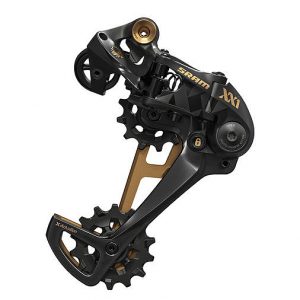
During a gear change the rear mech operation can be visualised as follows (typical Shimano rear mech). The rider operates the index shifter on the handle bar. This tensions or relaxes the gear cable by an exact amount. At the other end of the gear cable the rear mech is pulled or relaxed by the cable tension.
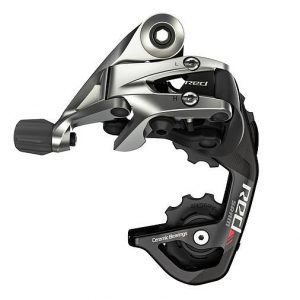
The rear mech distributes the chain via a cage mechanism that contains two toothed plastic jockey wheels, one at both ends of the cage. The chain enters the rear mech around the first jockey wheel at the lowest position, travels in an S shape around the second jockey wheel at a higher position and onto a cassette sprocket.
Tensioning of the gear cable pulls the cage containing the two jockey wheels laterally toward the rear wheel of the cycle and simultaneously downward so that the chain can be fed onto a larger sprocket (lower gear). In both directions, the movement is counter-sprung by the two springs to keep the cage in its desired location until another gear change is activated. Relaxing the gear cable results in the cage relaxing (the counter-spring pulling it back), and moving laterally away from the rear wheel of the cycle, and simultaneously upward so the chain is deposited onto a smaller sprocket (higher gear). It can be seen then, that the rear mech system operates due to counter-sprung cable tension, which in turn permits the jockey wheels to feed the chain onto the cassette.
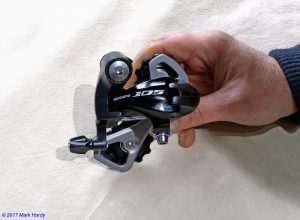
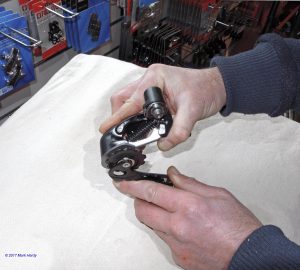
The counter-spring situated at the point where the rear mech attaches to the frame, also takes up the chain slack between the bottom jockey wheel and the chain ring on the chain set. This means that during pedalling, the amount of slack, (or low tension of the chain), between chain ring and bottom jockey wheel is the same for every sprocket on the cassette. The amount of chain slack required is determined by the combined diameters of the chain ring and the largest sprocket on the cassette. This is dealt with by the cage being a particular length and the jockey wheels being a particular diameter. For example, on a cycle with a cassette that has a smaller number of teeth on the largest sprocket e.g. 26t and a compact chainset, the required length of cage may be a Medium cage. A standard chainset and a cassette with a large sprocket of 32t may benefit from a Large cage.
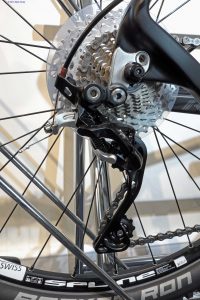
This counter-spring has another benefit. The chain run between the cassette and top of the chain ring is under high tension during pedalling. When free-wheeling, this tension is relaxed. The chain between the bottom of the chain ring and the bottom jockey wheel is under minor tension during pedalling and when free-wheeling. That amount of tension is enough to prevent the chain from jumping off the chain ring at the front.
In order for the jockey wheels to operate efficiently, they must be able to rotate freely and thus have bearings that facilitate this property. On entry level cycles, the rear mechs typically have jockey wheels that have simple bearings that are no more than a metal sleeve rotating in a lubricated plastic outer.
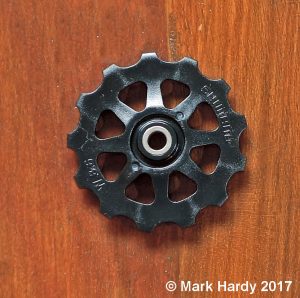
On higher quality rear mechs it is common to find that the upper jockey wheel that completes the transfer of chain to sprocket, contains a bearing with an extra metal sleeve, so that there is a metal to metal sleeve contact. This is because the upper jockey wheel has to take a higher load of forces.
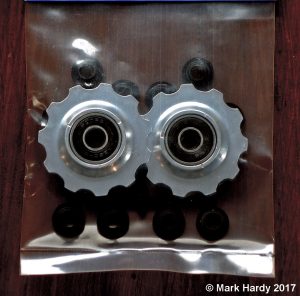
On the highest quality rear mechs it is usual to find plastic or even aluminium jockey wheels that contain press-fit ball racers as bearings.
Similar to the front derailleur, there are two small screws on a rear mech that set the upper and lower stop positions. These are the positions that prevent the rear mech from lifting the chain past the largest sprocket and into the wheel at one end of travel, and at the other end of travel, dropping the chain off the smallest sprocket and trapping it against the frame.
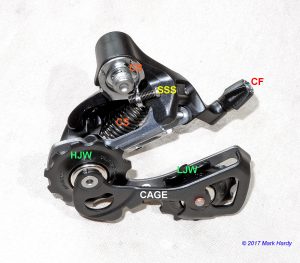
A rear mech also has an extra single screw.This is set to the position where the rear mech is wrapping the chain snugly around the sprockets.This provides a more positive gear changing from a small sprocket to a larger one.
The quality differences seen in rear mechs are in the areas of jockey wheel bearing efficiency, pivot point engineering tolerances and resistance to corrosion.
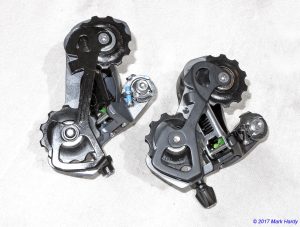
Some modern high quality road bike rear mechs are manufactured using carbon fibre. This is for weight saving. Road bikes at the lower end of the weight scale (<8kg) are desired by professionals and every little helps.
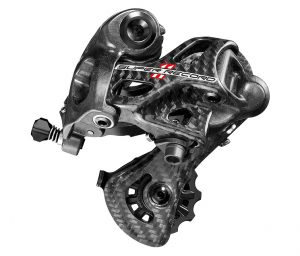
Rear mechs are hardy resilient mechanisms, but eventually can fail from corrosion and stiffness at the pivot points, wearing of the spring rubbing against metal, and slacking of the jockey wheel bearings. Jockey wheels require a small amount of lateral movement but bearing wear introduces tilt and waggle. With the chain removed, if the jockey wheels tilt and waggle side to side when spun by hand, it is usually time to change them.
The vast majority of factory built cycles use rear mechs from manufacturers such as Shimano, SRAM and Campagnolo (road bikes only).